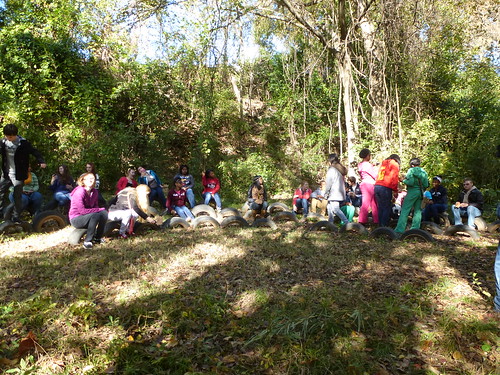Squawk! Caw! Coates Bluff Trail review -
1. Tree whose bark has small growths that resemble tiny volcanic peaks: __ .
a) Cottonwood b) Hackberry c) Sycamore d) Dogwood.
2. This tree has a mottled bark and gargantuan leaves: __ . a) Cottonwood b) Hackberry c) Sycamore d) Dogwood.
3. Type of oak that is most prevalent in North Louisiana river bottoms: __ oak.
a) Live b) Water c) Pine d) River.
4. This tree produces "knees," a sort of knobby growth that pokes up through the ground in the vicinity of the tree. __ . a) Cottonwood b) Hackberry c) Sycamore
d) Cypress.
5. Tree that produces puce-colored blossoms (purplish-reddish-brown) in the late winter: __ __ . a) Cottonwood b) Redbud c) Sycamore d) Dogwood.
6. If this woods vine isn't the 5-leafed Virginia Creeper it must be __ . a) Cottonwood b) Redbud c) Sycamore d) Poison Ivy.
7. The principal forest grapes of North Louisiana: __ . a) Cottonwood b) Redbud c) Muscadine d) Virginia Creeper.
8. When clay, sand and silt occur in a mixed soil, it is called __ . a) riparian
b) loam c) topsoil d) alluvial.
9. Louisiana is widely-known as a state with unusually rich bird life. T / F
10. The zone along a bayou is __ land. a) riparian b) conservation c) aquifer
d) up.
11. A woody, thick vine: a) pine b) rattan
c) oak d) cypress.
12. Tree used in bioengineering, medicine and for objects made of the soft wood: a) cypress b) willow c) cottonwood d) pecan.
13. Canopy trees - the tallest - of the Coates Bluff area include cottonwood and __ .
skip to main |
skip to sidebar
For students and parents who love education and exploration of the social sciences . . .
Search This Blog
Followers
Blog Archive
-
▼
2012
(254)
-
▼
November
(26)
- British Empire quiz
- The Thames, the Tower Bridge and the Tower of Lond...
- James Bond travels to cities once in the British E...
- 1st semester exam Study Guide, world geography 201...
- The many cultural connections to the British Empire
- Mapping a global adventure undertaken by MI6 Agent...
- English warships, soldiers and commanders built th...
- Semester exam: 50 questions plus a brief compariso...
- Traveling the globe with James Bond: the Skyfall quiz
- Crepe Myrtle Planting, Class of 2016
- Student essay: Dew-coated shoes on the Coates Bluf...
- Geography / Merrie olde England
- A promontory called Lands End, UK
- England: Henry VIII, Industrial Revolution
- England world geo ; Henry viii, Industrial Rev
- Historic London pop-up map: 12 pts
- The Basics of Rugby: part of an intro to Western E...
- Magnet geography: the UK
- Riparian fauna: raccoons and opossums inhabit burr...
- Mississippi River Delta Marshes are morphing
- Bayou Pierre fauna quiz
- Chinese tallow leaf in red: Bayou Pierre / Coates ...
- Willows, medicines and Coates Bluff Trail / geography
- Coates Bluff Trail, Shreveport
- Essay on Coates Bluff Trail, Shreveport
- Magnet geography: Coates Bluff map
-
▼
November
(26)

